In the Velvet Goldmine there are fortunes and graves. Ghosts of yesteryear whisper along with songs from a glamorous age gilded by nostalgia. Meanwhile, flecks of gold that seemed like the motherlode glitter all around. It’s a magical place full of seemingly infinite possibility as well as heartbreak and tragedy, but such is the world of rock’n’roll.
Released in 1998, Velvet Goldmine is the campy offspring of writer-director Todd Haynes. The movie is a celluloid love letter to the glam era of rock, particularly its 1970s heyday. However, the film manages to be about more than music, while making music everything.
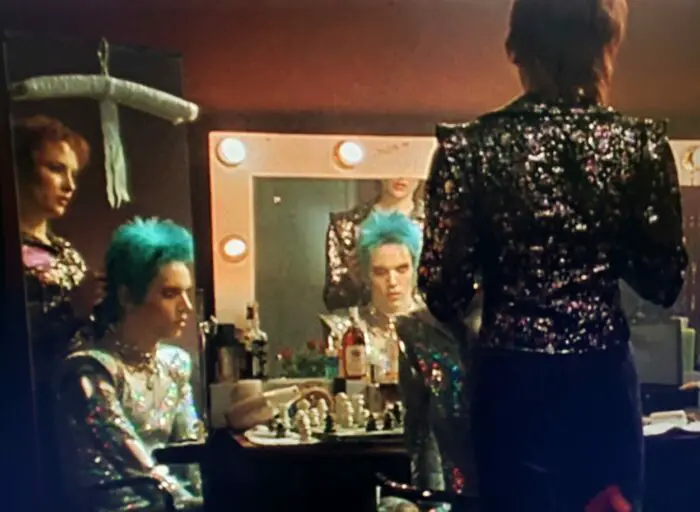
The simple synopsis of Velvet Goldmine is a David Bowie-inspired biopic. Since the singer never gave permission to use his identity or music, Todd Haynes found himself liberated from the facts. This allowed him to craft a story not so much about Bowie but the idea of the artist, a freedom he’d revisit in 2007 with I’m Not There. This saved Velvet Goldmine from being a predictable biopic, permitting it to become a counterfactual account of the performer and the glam era he inspired.
The story orbits the myth of Brian Slade as characters look back à la Citizen Kane. The impetus for these reflections are inquiries from journalist Arthur Stuart played by Christian Bale. Some of his own memories intersperse the unfolding narrative as audiences learn the rise and fall of a pop rock icon. The result is an ambitious experimental film exploring society, sexuality, and celebrity.
What sets Velvet Goldmine apart from other biographical films is that these recollections become more than mere facts if they include facts at all. Whenever the story slips into the past, especially while recounting Brian Slade’s career, events often metamorphosize into metaphorical scenes. Some moments even unfold like music videos rather than real life. Colors change between eras with the past more alive thanks to vibrant, vivid hues. Press junkets turn into circus performances with Slade at the center. Et cetera, etc., the film revealing as well as being extravagance in the pursuit of the glamorously extraordinary.
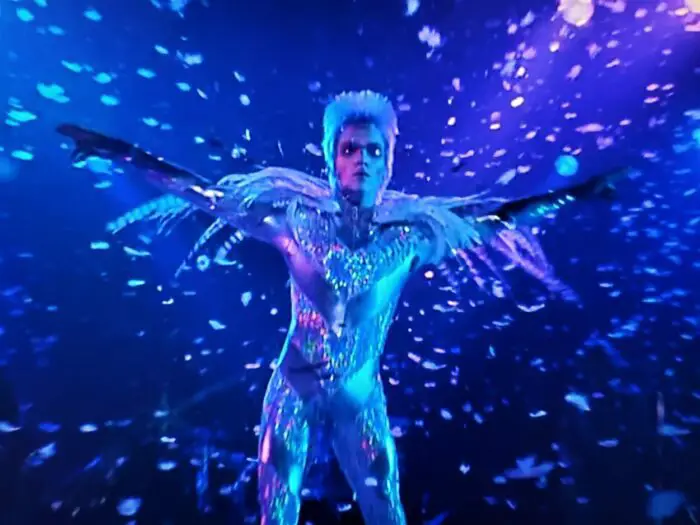
Doing so allows Haynes to paint an impressionistic portrait implicative rather than realistic. Velvet Goldmine visually suggests a subtext of how memories alter. The movie’s more experimental scenes hint at how people change their own history, especially in the case of celebrities where it all becomes a grim fairy tale. In other words, at times Velvet Goldmine doesn’t show what happened so much as it shows what seemed to happen.
This is set up brilliantly with a teacher reading a quote from Oscar Fingal O’Flahertie Wills Wilde’s “The Portrait of Dorian Gray”. The passage remarks on, “the record of his own life, not as he had lived it in act and circumstance, but as his imagination had created it for him, as it had been in his brain and in his passions.” Other lines from the notorious epigrammatist pepper Velvet Goldmine, particularly when popstars attempt to seem clever.
Of course, no one ever cites a quote when it’s delivered. This borrowing is another facet of the film’s various explorations. Consider young fanboy Arthur mimicking Slade’s aesthetic which is itself clipped from bits of another character Jack Fairy. In this way, self-expression is a self-conscious act whereby people become constructs instead of authentic individuals. Yet, the freedom of such masks is no less liberating.
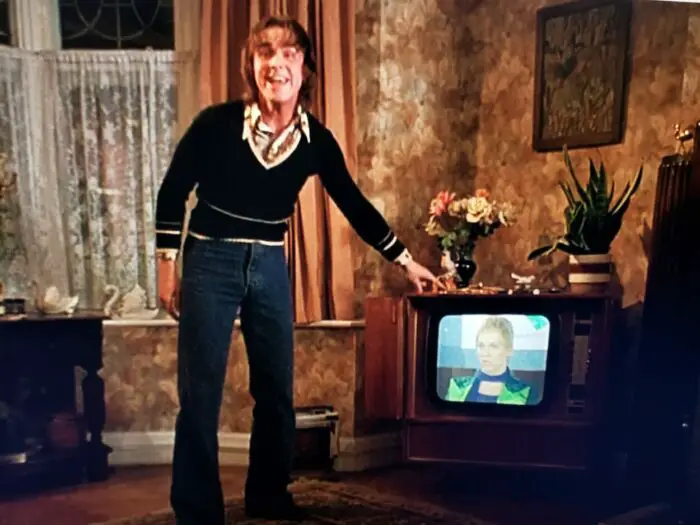
By adopting glam aesthetics Arthur becomes more comfortable with his own blossoming sexuality. There’s even an adorable scene where he recalls watching Brian Slade being interviewed on television. He imagines what he wished happened; that he started hopping up and down while enthusiastically pointing at the flamboyant rocker onscreen gleefully yelling at his parents, “That’s me!”
As observed in “Phrases & Philosophies for the Use of the Young” by Wilde, “One should either be a work of art, or wear a work of art.”
Aspiring to be that work of art, Brian Slade constructs the persona of Maxwell Demon. Portrayed by Jonathan Rhys Meyers, the rocker’s ascent to stardom comes to life brilliantly. The performance captures a gender-fluid androgyne catapulted to fame through extravagant displays and démesuré ambition, but it contains wonderful flashes of humanity behind the façade. Rhys Meyers conveys as much in one facial expression as some do in a whole monologue.
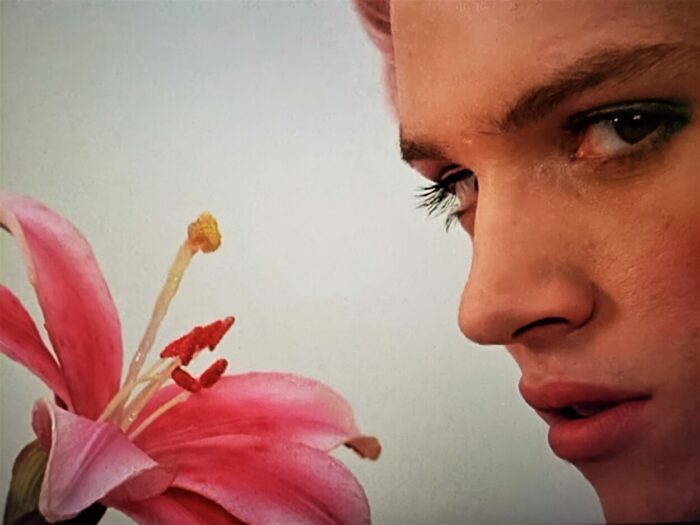
Such subtexts are an important part of the film because Velvet Goldmine is often more about what’s left unsaid. This is where its visual component really comes into play. For example, a surreal scene exploring the paparazzi stalking famous folks is all well and good, but the playfulness of the moment gives off ominous undercurrents. When a flashbulb explodes, the smoke clears revealing Slade’s face artfully shredded by glass shrapnel. He doesn’t seem terribly injured, though the damage is clear, while a breathless Rhys Meyers has fear in his eyes.
Perhaps the best display of this all coming together is Toni Collette’s presentation. She plays Mandy Slade, a U.S. transplant who tends to speak in a ridiculous faux British accent. Modeled on David Bowie’s first wife, Angie, Mandy encourages Brian’s transformation into Maxwell Demon. They dress alike and openly engage in bisexual intercourse at drug filled orgies. Yet, the vibrant hedonistic Mandy is only seen in recollections.
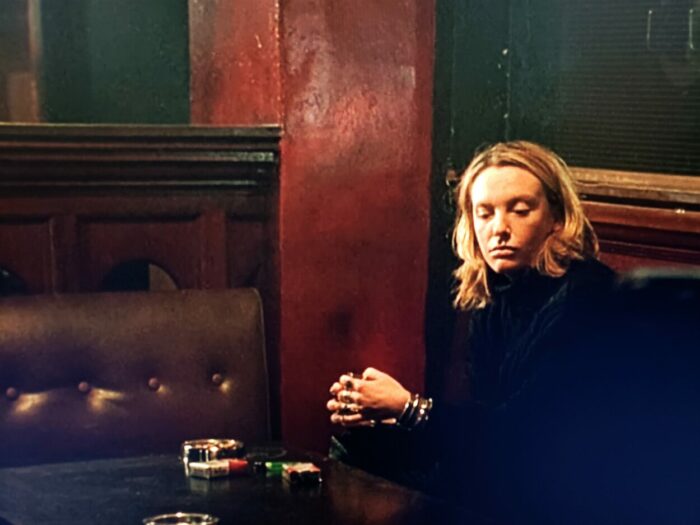
When journalist Arthur Stuart tracks her down, the audience isn’t introduced to an effusive individual in gaudy clothes. The viewer finds a woman all in black, sitting alone in a dive bar. There’s no trace of British in her voice and the carefree easy smile of old seems long dead, traded in for a perpetual glum expression. Toni Collette pulls off these two extremes with an envious ease that helps contrast the lost past with the film’s depressed present.
Color is literally gone from the lives and world of the main characters. Meanwhile, Mandy’s recollections are some of the most flamboyant and surreal. However, one memory is plain history. In it she recounts giving Brian divorce papers. During the scene her voice changes, the British dropping away as emotion overtakes her—the artifice breaks. It’s a combination of visual contrasts paired with superbly subtle acting that exposes a number of narrative facets without a single line of dialogue directly referencing anything.
Consider another subtext-driven set up. It involves the fictional band The Flaming Creatures, brought to life by real 90s alt-rockers Placebo. Having just met young Arthur Stuart, the musicians proceed to unload a stream of artistic statements about everything from their music to how they think life should be lived. It mirrors an earlier moment with Brian Slade and his coterie of hired extravagant sycophants spouting pretentious lines. But when The Flaming Creatures ask Stuart for his own motivations, what matters most to him, he simply replies he needs a place to live.
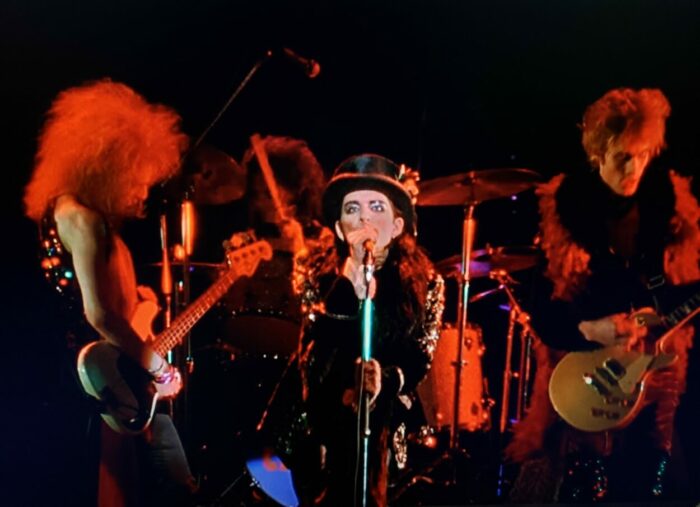
Having been kicked out of his home there’s no time for artistic pretentions. The cold night street awaits regardless of any camp sensibilities or idealistic notions. It’s a fabulously sharp point popping the bubble. Unless Mona Lisa doubles as an umbrella, art can’t spare a person from the cold rain. Granted, The Flaming Creatures rescue Arthur from homelessness, but the message lingers: this scene is only a temporary escape from reality.
These kinds of moments speckle Velvet Goldmine like grim glitter. Few films so clearly capture the need for escapism as well as the limitations of such reprieves from reality. In essence exposing that this glamourous extravagance in all its campy glory is paint not the bricks to build a life.
As Susan Sontag wrote in “Notes on ‘Camp’”, “the sensibility of an era is not only its most decisive, but also its most perishable, aspect” and “rare are those historical studies… which do tell us something about the sensibility of a period.”
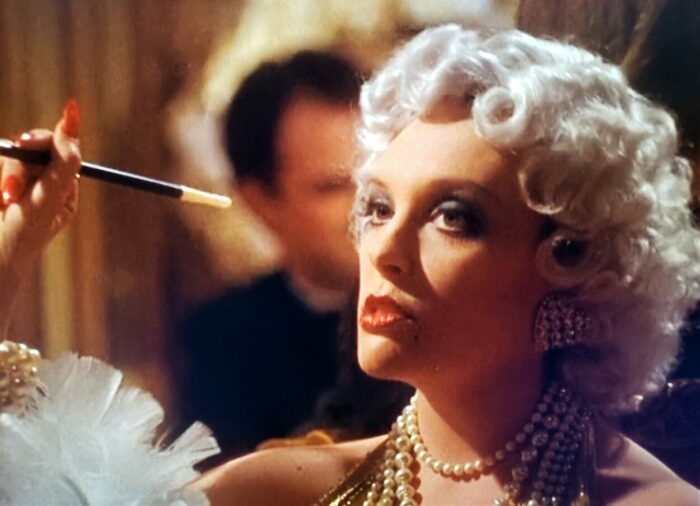
What helps Todd Haynes express a lot of this is the music. Velvet Goldmine is a borderline musical, operating more like a visual album than a motion picture. The soundtrack features not only sensational needle drops but pitch perfect originals. Again, not allowed to use Bowie’s music, the filmmakers employed high-tier talents to craft phenomenal soundalikes.
There’s Shudder to Think performing the Ziggy-esque “Ballad of Maxwell Demon”. Grant Lee Buffalo’s “The Whole Shebang” marvelously mirrors Bowie’s vaudevillian pop off “Honky Dory”. Thom Yorke of Radiohead fame lent his voice to the fictional Venus in Furs, providing a remarkable imitation of Bryan Ferry. There’s also an amazing cover of Cockney Rebel’s “Sebastian” sung by Jonathan Rhys Meyers that is, as far as I know, criminally unavailable anywhere.
It all comes together in a way that makes the movie inseparable from its soundtrack. Covers even take on subtle shifts such as Placebo as The Flaming Creatures performing T-rex’s “20th Century Boy”. Though the tunes sound almost exactly alike, there’s a little more distorted snarl in The Flaming Creatures’ guitars making the song sound more aggressive. And though glam may not strike some as in-your-face rock’n’roll, Todd Haynes manages to prove it is, infusing the era with attitudes more likely associated with punk.
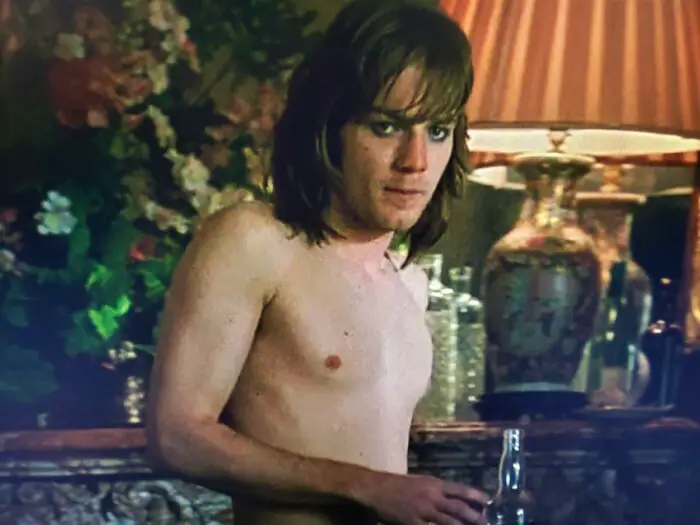
It may seem like I’m referring to the character of Curt Wild, played by Ewan McGregor and unmistakably modeled on Iggy Pop. In a word, yes, but not because of his intense musical style and outlandish performances. Rather, the overt love story involving him and Brian Slade.
The kind of people who faint at the whispered implication of two men kissing will likely die of shock watching Velvet Goldmine. It’s an unapologetically gay film featuring passionate same-sex kisses and tender embraces, where physical expressions of love speak to deeper feelings beneath. Velvet Goldmine reminds how identity politics and the search for safe self-expression is not a recent issue. It’s an ongoing struggle and those affected by it, in their search for acceptance, often embrace iconic individuals bold enough to openly be what sets them apart from society.
But deeper into the story, the movie reveals the dangerous double-edged sword wielded by such champions when they’re popstars. The problem being these are self-consciously constructed personas rather than real people. Regardless of whatever authentic elements inspired their act, they don’t have to live in the world after the concert. It’s all a bubble that pops when the music stops.
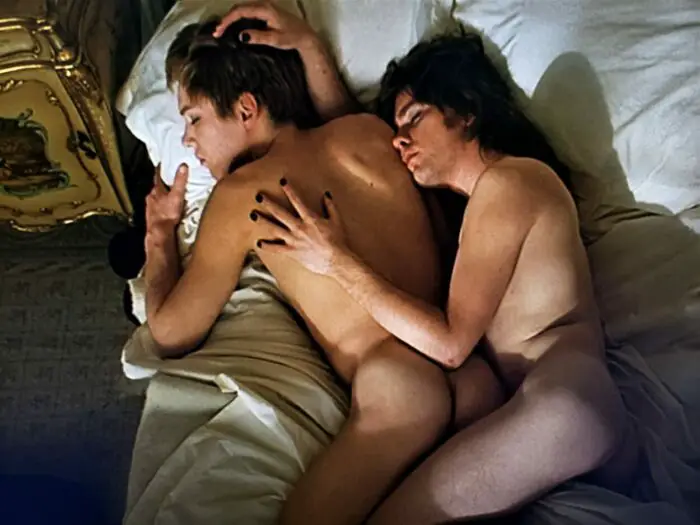
Critically, Velvet Goldmine did not fair well. CNN’s Paul Tatara wrote that beneath, “the silvery glitter eyeshadow, there’s absolutely no movie.” Roger Ebert was equally unkind, taking time to lament the film wasn’t more reverently fawning regarding its Bowie inspirations. He complained audiences never really learn anything real about Brian Slade which astonishingly misses the very point being made. He’s a character without much reality, crafted the same way David Jones created Bowie who made Ziggy Stardust.
Todd Haynes tackled the negative press by saying, “They want their historical dramas to be authentic and that was the least of my intentions… I took [the glam] tenets — dressing up and being fantastical and non-authentic — and tried to apply them to a film.”
Granted, not everything works perfectly in Velvet Goldmine. Observing a sex scene through what appears to be running water may serve little apparent purpose other than visually poetics. The narrative can be disorienting to some. Maybe if French financiers CiBy 2000 hadn’t collapsed shaving a million dollars and weeks off the production, Velvet Goldmine could’ve stuck the landing better. But only artifice is perfect.
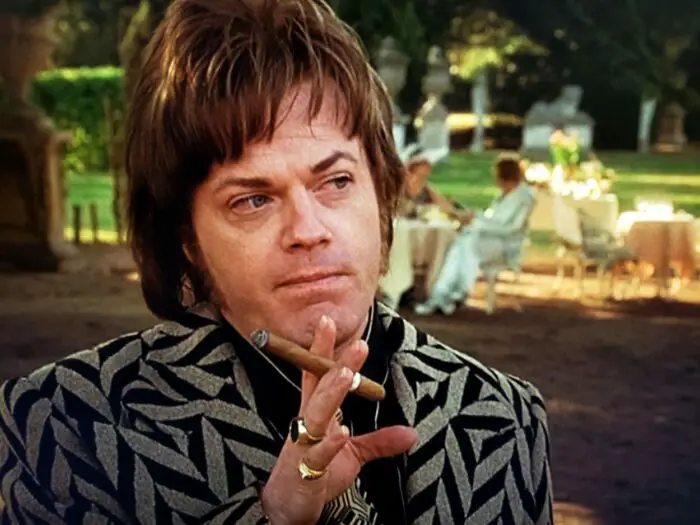
There are those who like to spend their time deducing which real people inspired characters in Velvet Goldmine. Although valid, given the Bowie branch it blossomed off, such a perspective limits the movie. It’s like focusing on the points of color instead of seeing Seurat’s whole A Sunday Afternoon on the Island of La Grande Jatte.
Velvet Goldmine is a treasure trove proving great art grows beyond an individual and is composed of all whom it touches. Through a marvelous mix of musical brilliance, cinematic experiments, and narrative risks, it makes the ordinary more interesting. That’s why 25 years later, some still dig it.



